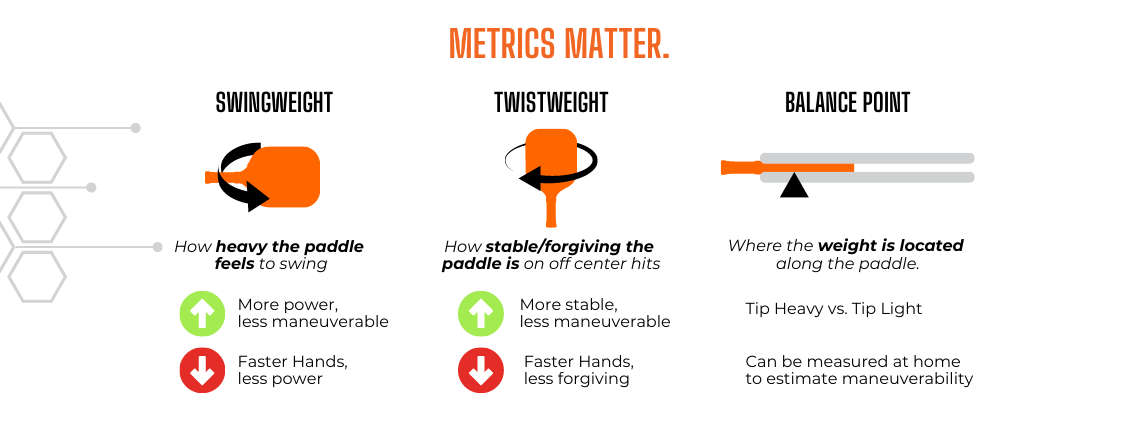The Lab at Pickleball Central: Why Swingweight, Twistweight, and Balance Points Matter in Pickleball
by Joseph Sutton on Aug 3, 2023
Alongside our partners at HEAD Pickleball, we are happy to present the 4-in-1 Racket and Paddle testing machine, the first machine of its kind to measure Static Weight, Swingweight, Torsional Stability known also as Twistweight, and Balance Point for Both Tennis rackets and Pickleball Paddles. Let’s walk through these terms and why they matter for pickleball.
Static weight is how heavy the paddle is without moving, basically just putting it on the scale and reading the result. Historically people have shopped for paddles based primarily on static weight, and while it does play a factor, understanding swingweight can better help you find and customize the right paddle for you.

The swingweight of a pickleball paddle is a measure of how heavy the paddle feels when swung and is determined by how that weight is distributed throughout the paddle. A paddle with a high swingweight will feel heavier when swung, even if it has the same static weight as a paddle with a lower swingweight. The classic example here is the hammer that feels heavy swinging it from the handle, but very light swinging it while holding the head, even though the static weight does not change at all.
Players often prefer a certain swingweight based on their playing style and preferences. A higher swingweight can provide more power and stability but can be too slow or painful to wield for some, while a lower swingweight can provide more maneuverability and paddle control but can lack power and forgiveness. Swingweights range from low to very high, and you can check out our graph to learn where your paddle falls or what you’re looking for in your next paddle.
The distribution of weight in a paddle is measured partially by finding its balance point, or the point where there is equal weight on both sides. Knowing a paddle’s balance point can help us understand its maneuverability, which most comes into play when we talk about hand speed. Balance is often measured in points where each “point” represents a balance point a quarter inch away from the actual center of the paddle. If a paddle has a balance of +6 points, the balance point is 1.5 inches away from the center of the paddle towards the top. While it is possible for this to be a negative number, pickleball paddles are almost always slightly “head heavy” and have a balance point closer to the head than the buttcap. Paddles with a low balance point are considered extremely maneuverable, while paddles with a high balance point are considered head-heavy and can be great choices for big swingers and players looking for more power than maneuverability. Paddles in between these two are considered “balanced” and have a good mix of both characteristics.
Twistweight, or torsional stability, measures how resistant to rotation the paddle is which effectively describes the stability of the paddle when the ball is hit outside the center of the face. A paddle with a high twist weight will rotate less when contacted off center resulting in a shot similar to hitting the sweet spot, while one with a lower twist weight will be easier to get into position but more reactive to off-center hits. High twistweight paddles are often described as having a huge sweet spot, and players will often add weight to the side of their paddle to increase its twistweight and make it more stable. There is a tradeoff of paddle face maneuverability as twistweights get higher, so it’s important to find a balance that allows you to get your paddle in position and offer the forgiveness you need. Weight on the perimeter and paddle face width affect twistweight the most, making thicker and wider paddles some of the most stable on the market like the Engage Pursuit EX 6.0, while thin and skinny paddles can be some of the most maneuverable like the Gearbox CX14E Ultimate Power Pickleball Paddle with balanced paddles falling in between. Just like swingweight, it’s important to remember that adding weight to the perimeter of the paddle can increase twistweight, but there is no way to decrease the twistweight of a stock paddle.
Shop Electrum Model E Elite 16mm Carbon Fiber Pickleball Paddle
Shop JOOLA Collin Johns Scorpeus CFS 16 Carbon Fiber Pickleball Paddle
Shop Selkirk VANGUARD Power Air Invikta Paddle
Shop HEAD Gravity Tour Pickleball Paddle
Understanding these concepts can seem daunting at first, but as you grasp them you will be able to better understand what paddle is right for your game and why, so when it comes time to upgrade, you’ll have actual numbers you can use instead of just marketing hype. If you only take one piece from this article, let it be the importance of swingweight, as it will play the biggest role in finding or customizing a paddle that maximizes your success on court.
The HEAD 4-in-1 machine will be available for purchase in the near future, but we know that not everyone is going to be able to put one of these in their house, so Pickleball Central will be posting average Static Weights, Swingweights, Twistweights, and Balance Points for new paddle launches as well as testing current and older models so that you can compare stats for these paddles anytime you visit our site.
What paddles do you want to see tested first? Let us know!
Share Product:
SHARE THIS:





